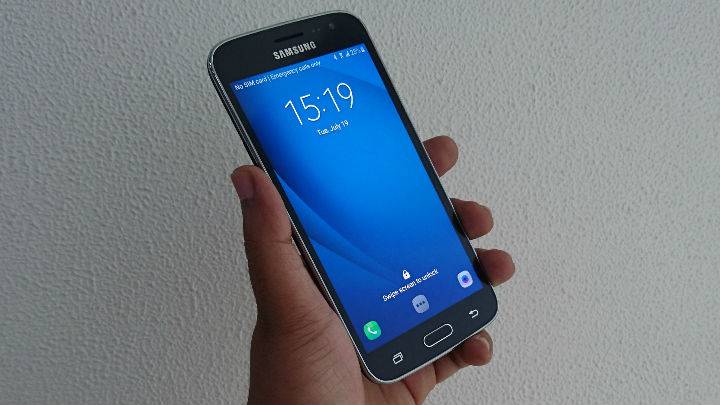TechRadar Verdict
While it does have a few positives with a good display, front camera and battery life, the Galaxy J2 2016 compromises on too many essentials. The extremely dated internals, 8GB of internal storage, the all plastic build and the lack of an ambient light sensor make it a very sub-par offering from Samsung.
Pros
- +
Decent screen and battery life
- +
Compact dimensions
- +
Above average front camera
- +
Smart Glow is a nice idea
Cons
- -
Mediocre design
- -
Dated and slow internals
- -
Lack of basics like the ambient light sensor
- -
Smart Glow not practical
- -
No Gorilla Glass and only 8GB of internal storage
Why you can trust TechRadar
Design 2.5/5
Features 2.5/5
Performance 2/5
Usability 3/5
Value 2.5/5
The Samsung Galaxy J2 2016 is a follow up version of the Galaxy J2 launched in 2015.
Galaxy J2 2016 has been re-engineered and re-designed with new 'Make for India' features such as Turbo Speed Technology (TST), which Samsung claims results in superior device performance, and Smart Glow, a colour LED notification system.
According to Samsung, the Galaxy J2 is India's largest selling smartphone and the J2 2016 aims to build up on the success of its predecessor.
The smartphone, priced at Rs 9,750, finds itself in a heavily saturated and competitive marketplace, populated by the likes of the recently launched Moto G4 Play, the LeEco Le 1s Eco, the slightly more expensive Redmi Note 3 and the Asus Zenfone 2.
Does Samsung's new budget competitor have what it takes to battle it out with these segment heavyweights? Let's find out
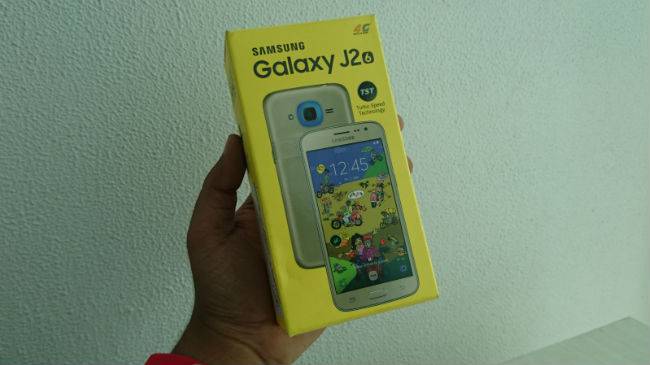
Specifications:
Display : 5-inch 720p HD Super AMOLED display
OS : Samsung's TouchWiz UI running atop Android 6.0.1 Marshmallow
CPU : 1.5GHz 32-bit Spreadtrum SC9830
RAM : 1.5GB
GPU : Mali-400 MP2
Storage : 8GB internal storage, microSD support
Cameras : 8MP f/2.2 rear camera (LED flash), 5MP f/2.2 front camera
Connectivity : Wi-Fi, 3G/4G/2G, GPS, Bluetooth, microUSB 2.0
Battery : 2,600mAh
Dimensions : 142.4 X 71.1 X 8.0 mm
Price : Rs 9,750
Design
For many years, Samsung was known for making plasticky handsets with mediocre build quality and uninspired designs. Then came the Galaxy S6 and the S6 Edge which ushered in a svelte metal and glass design that stunned many.
From the days of the ungainly and bulky Galaxy S5, Samsung transformed it's ugly duckling into a beautiful swan with the Galaxy S6.
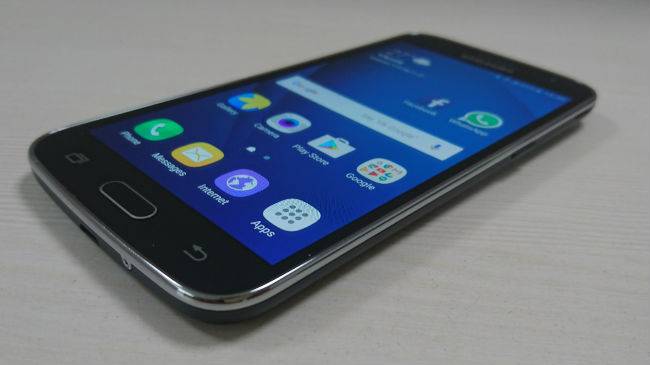
Now you will be asking why I am talking about the flagship Galaxy in an article reviewing the J2.
That's because even though Samsung has made serious headways when it comes to design in its flagships, the same cannot be said for its low and mid-range devices.
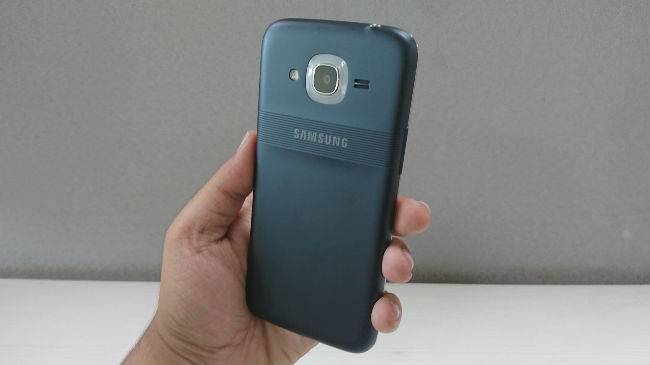
Some attempts have been made by Samsung in the form of the metal infused A series and the inclusion of textured lines along the sides and underneath the Samsung logo on the back in the J2.
However, with the competition seriously stepping up its game when it comes to build quality and design, the Samsung Galaxy J2 looks uninspired and boring.
Build Quality
The build quality of the device is also nothing to write home about. The all plastic construction doesn't inspire much confidence and feels rather cheap.
The back is removable and is very smooth and slippery. As with every J series smartphone, the quality of the removable back panel is rather poor. However, it must be noted that the back panel is of a better quality than the one found on the Samsung Galaxy J5 and J7, which feels like it will break with just a modicum of force.
The removable back comes with the usual advantages of having a removable battery and easy access to the two SIM card slots and the microSD card slot.
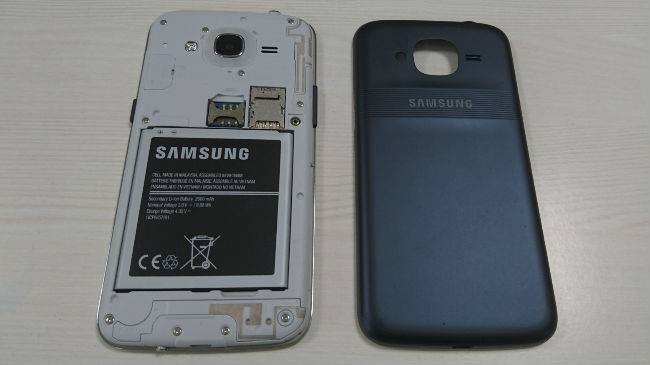
The volume and power keys are a bit on the small side and are very hard and clicky. The single external speaker unit is loud enough, but sounds muddled and tinny at full volume. The earpiece is great though and calls made through the phone could be heard loud and clear.
Samsung needs to realise that the market landscape has changed drastically, with the introduction of Chinese brands who have helped push the envelope forward when it comes to design and build quality.
It's high time Samsung stops riding on the wave of its brand name and starts taking the design and build of its lower end devices seriously.
Connectivity/Sensors
On the connectivity front, the Samsung Galaxy J2 2016 is a dualSIM device that supports 4G LTE, 3G, Wi-Fi 802.11 b/g/n, Bluetooth V4.1 and GPS. It comes with a proximity sensor and an accelerometer.
What is missing?
Auto brightness sensor? Doesn't exist Haptic Feedback? No. Notification LED? No. Fingerprint Sensor? No. Noise cancelling secondary microphone? No. NFC? No.
The Samsung Galaxy J2 lacks basic sensors which became commonplace on smartphones years ago. I fail to understand why Samsung refuses to equip their low end smartphones with these, as they would cost the company next to nothing.
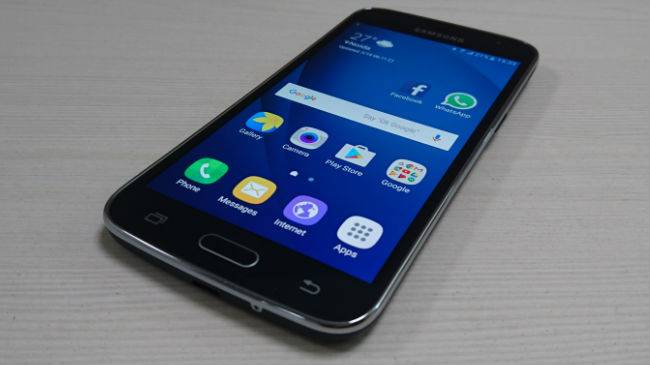
Not having an auto brightness sensor, noise cancelling microphone and haptic feedback is just inexcusable in 2016.
One can make a case that the Notification LED is not needed because of Smart Glow, but we will come to it later as to why Smart Glow is not as 'revolutionary' as Samsung claims.
At the price, the lack of a fingerprint sensor is not that much of a deal breaker, but shouldn't we expect the best from the leading smartphone manufacturer? Smartphones such as the Coolpad Note 3 and LeEco Le 1s come with a fingerprint sensor in the same price range.
Now, the J2 doesn't support NFC. But, the J3 at Rs 8,499 does. This is another example of Samsung's penchant of making too many smartphones and deliberately leaving out one or the other feature from a device just to differentiate it from its other similarly priced devices.
Display
The display, in trademark Samsung fashion, is a sAMOLED panel and thus has ultra-vivid colors, which border on looking a tad unrealistic.
The blacks are deep and inky and images and video 'pop' on the screen. The viewing angles are also great and so is sunlight legibility.
Of course due to the lack of an auto brightness sensor, you would have to manually increase the brightness every single time you go outside. Samsung has included something called an outdoor mode, which can be activated by a toggle that sits right next to the brightness bar in the quick setting toggle.
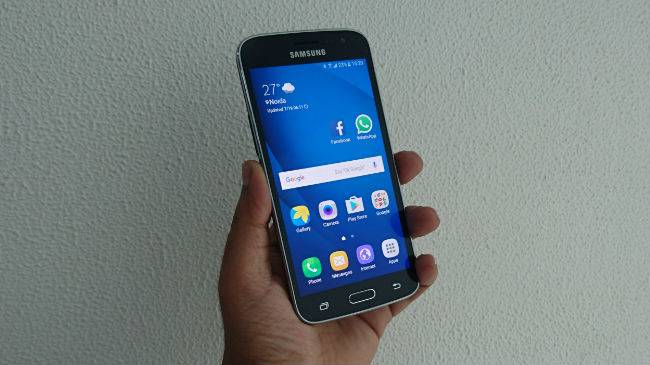
This outdoor mode maximises the display's brightness for a period of 15 mins, after which the brightness reverts back to the previous setting.
This outdoor mode is well and good, but it's need is necessitated only because of Samsung's reluctance to include a basic sensor.
Overall, the display is actually the redeeming factor of the Galaxy J2 2016, which underperforms in almost every other aspect.
Hardware
The Samsung Galaxy J2 is powered by the 32-bit Spreadtrum SC9830 processor clocked at 1.5GHz coupled with a Mali-400MP2 GPU, 1.5GB of RAM, 8GB internal storage (expandable via a microSD card slot) and a 2,600mAh battery.
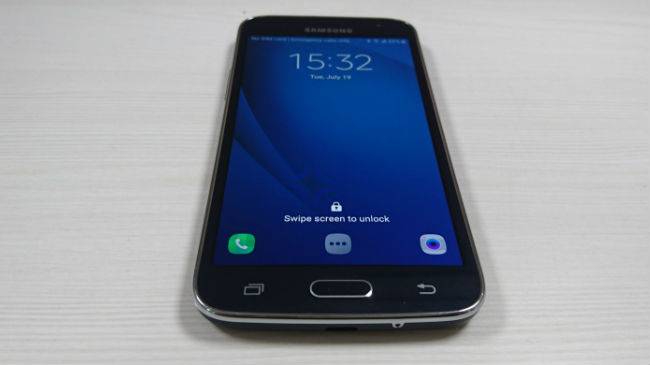
The Galaxy J2 also comes with 2 unique features, Smart Glow, a color notification LED system and Turbo Speed Technology (TST), which according to Samsung helps improve the device's speed and performance. We will talk about these features in detail further on.
8GB of internal storage is a big disappointment, and the phone comes with only 3.6GB of usable storage out of the box. With just our benchmarking applications, Facebook, WhatsApp and 3 games, the phone was just left with 1.4GB of internal storage.
Performance
Before we talk about the Samsung Galaxy J2 2016's performance, or lack of it actually, we need to talk about the CPU and GPU that Samsung has included in the smartphone.
Samsung is marketing the device as having a 1.5 GHz quad-core processor. To the layman, this sounds great, quad-core means good performance!
But no.
The 32-bit Spreadtrum SC9830 processor runs four Cortex A7 cores. The smartphone world stopped using Cortex A7 over two years ago. ARM announced the Cortex A7 back in 2012, and was seen in the first generation Snapdragon 200 and 400 processors.
In fact, all low end devices these days use the 64-Bit Cortex A53, which is much more modern and efficient than the obsolete A7.
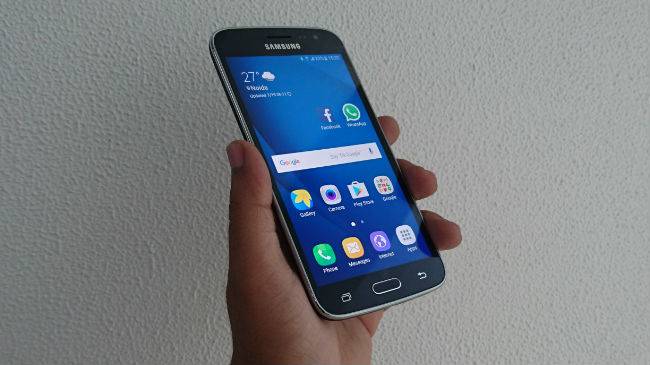
Now let's talk about the GPU.
The Galaxy J2 2016 comes with the Mali-400 MP2 GPU, a dinosaur in today's day and age. Let's put things into context. As pointed out by C4E Tech on Youtube, Samsung used the same GPU in its Galaxy S2 smartphone in 2011.
The version of the Mali 400MP2 on the S2 had a higher clock speed and 2 more cores and was used to power a 480p display. Now Samsung has included a less powerful version of the MP2 to power a 720p HD display.
Thus, the performance on the Galaxy J2 2016 is sub-par to say the least. The UI feels laggy, apps take a second or two extra to load, web browsing is frustrating and the camera itself is slow to focus and take pictures.
Gaming performance is average at best. Simple games like Subway surfers and Candy Crush Saga play reasonably well, but heavier games are best avoided.
Turbo Speed Technology
Samsung claims that Turbo Speed Technology (TST) is a revolutionary innovation which results in superior device performance. Samsung has rewritten native apps such as camera, gallery, and contacts, etc. that are most frequently used by consumers in order to make them as light as possible.
It also proactively shuts down idle processes running in the background and declutters RAM using its intelligent memory system to ensure resources like RAM and processor are free and ready to take on new tasks.
In real use, TST is a mixed bag.
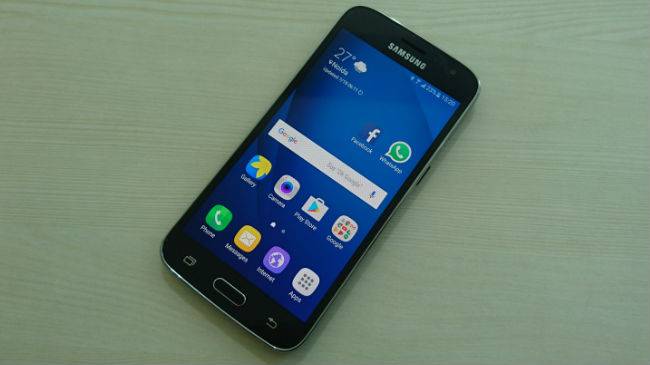
TST does make a contribution to Samsung's built in applications, with apps such as the Gallery, Music app and E-mail loading very swiftly, but it does not make any contribution to third party applications and the general UI itself is also very laggy.
TST is a nice concept and does help speed up some parts of the OS, but it is not a substitute for proper hardware. TST needs to be paired with a decent CPU and GPU in order to be genuinely useful.
No amount of software optimization can compensate for excruciatingly slow and dated internals. Period.
Smart Glow
Smart Glow consists of an LED ring around the rear camera which can be customized for priority notifications of any app or contact. It also alerts a user if they are running low on battery, internal memory, or mobile data.
You can choose any color you want, and there is a full RGB color picker. While does this offer infinite combinations, it is a bit difficult to use as there is no preview of the color on offer in the interface.
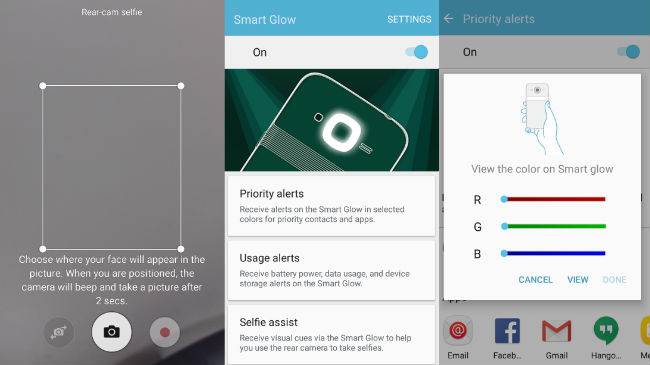
There is also a selfie assist feature which uses Smart Glow to help take a selfie with the rear camera.
Smart Glow is a nice addition, and is genuinely useful in certain scenarios but is not implemented practically.
Getting notified when your battery is about to die or your storage is about to get full and knowing who is calling simply by seeing the color of the ring is really convenient and is a nice feature to have.
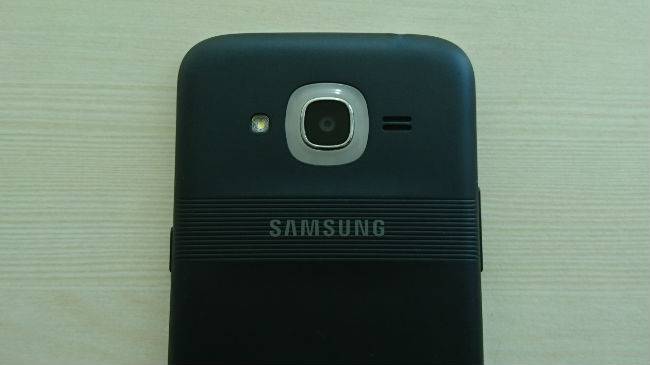
However, the fact that in order to use Smart Glow, you have to place your phone with the screen facing down limits the practical use of this feature considerably.
What compounds this problem further is that the display is not protected by Gorilla Glass. As the normal use case of Smart Glow would involve the screen being exposed to a table or other hard surfaces, the lack of Gorilla Glass can lead to scratches.
Software
The Samsung Galaxy J2 2016 runs on Samsung's own TouchWiz UI running atop Android 6.0.1 Marshmallow. Doze mode, application permission control and all other Marshmallow goodness is on offer here, just with a dash of Samsung's customisation.
Out of the box, the quick notifications tray has 18 icons, which thankfully are user customisable and can be whittled down to a more reasonable size.
Long pressing the home button opens up Google Now on Tap and a double press leads to the camera app instead of Samsung's rarely used S Voice. It's good to see Samsung finally ditching S Voice for the much more popular and powerful Google Now.

Out of the box, the device comes with tons of pre-loaded applications, including a whole suite of Microsoft Applications, namely Word, Excel, PowerPoint, OneDrive, OneNote and Skype. Thankfully, these can be uninstalled.
Samsung has gone the extra mile in the Galaxy J2 in simplifying TouchWIz. As a part of the Turbo Speed Technology, Samsung has decluttered the OS and made certain changes aimed at simplifying the user experience.
For example, the application list in now vertical scrolling instead of horizontal, which makes it much easier to navigate to whichever application you want to open, especially if you have a lot of apps installed.
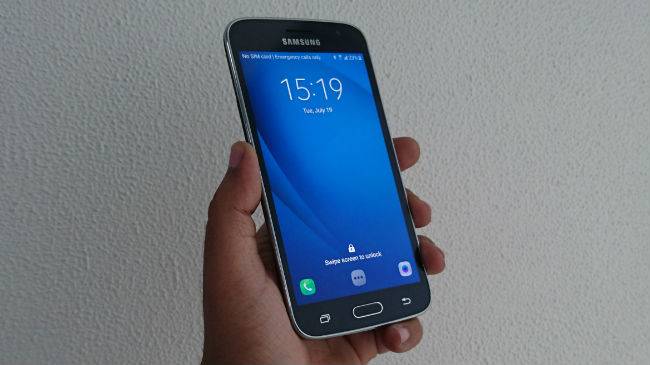
Samsung has also included shortcuts for the Calculator, FM Radio, Flashlight as well as a mirror application right on the lock screen. As these are not content sensitive, these can be accessed without entering the device's password.
Additionally, the OS doesn't automatically place shortcuts for newly installed applications on the home screen in a bid to avoid clutter.
All these modifications are great, and do help make this iteration of TouchWiz the best I have used to date in terms of user friendliness. However, compared to stock Android, TouchWiz still seems a bit incoherent and messy.
Ultra Data Savings Mode
The J2 2016 also comes with Samsung's much touted Ultra Data Savings mode, which Samsung claims provides up to 50% mobile data savings by blocking unnecessary background applications from consuming data.
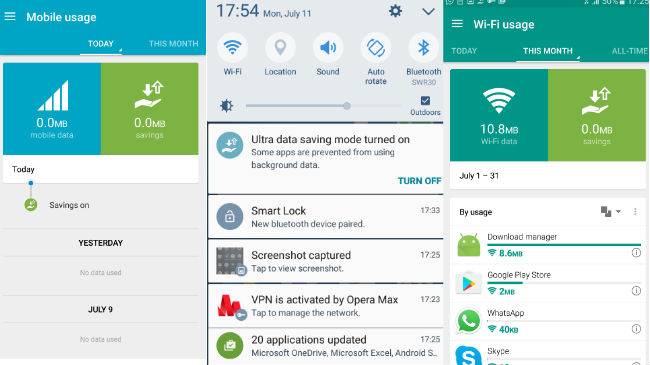
While the Ultra Data Savings Mode is a genuinely useful application, it is nothing but a repackaged Opera Max, which can be downloaded on any phone and will prove the same functionality.
It is great that Samsung integrates it directly into the OS, as not many people are aware of Opera Max, but what irks me is how Samsung claims it is something extremely innovative and unique.
S Bike mode
The Samsung Galaxy J2 2016 also comes with Samsung's much hyped S bike mode. The smartphone comes with a specialised NFC sticker/tag that sticks to the bike fuel tank. The rider needs to switch on the S bike mode on the smartphone before setting off on the ride, and then tap the sticker with the handset.
Upon activation, the S bike mode mutes incoming calls and notifies the caller with an automated message that the user is riding a two-wheeler and cannot take calls at the moment. If however, the caller wants to convey a message urgently and cannot wait for the rider to call back, then he/ she has the option of redirecting the call by pressing 1 on their smartphone.
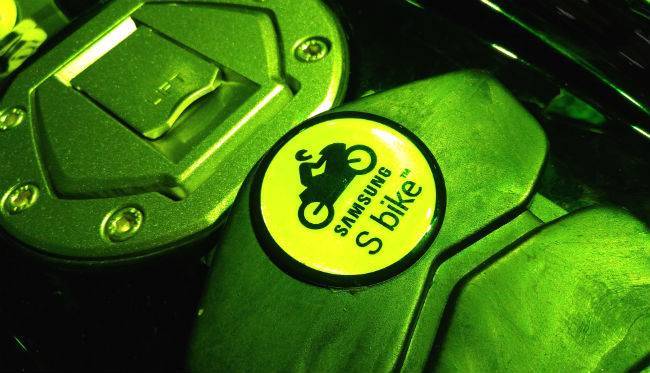
When the caller does this, the Samsung Galaxy J2 2016 notifies the rider that the call is urgent by playing a different ring tone. Now comes the best part, to prevent any accidents, S Bike mode will not let the rider attend the call until he halts the two-wheeler.
The implementation is good however we think that the idea of notifying the rider by just playing a distinct ring tone can be easily missed on noisy Indian roads. To make it more intuitive, Samsung could have added a LED light bulb on the NFC sticker/tag.
S Bike mode, while an interesting and unique initiative, seems to be just a gimmick, and not really an essential feature.
You can read more about the S Bike mode in our dedicated review here.
Camera
The Samsung Galaxy J2 comes with an 8MP rear camera with autofocus and LED flash and a 5MP front camera. Both the cameras have an aperture of f/2.2.
The rear camera is above average and in well-lit situations, it produces sharp and vibrant images with vivid colors. In outdoor low light situations however, images lack detailing and have a noticeable amount of noise.
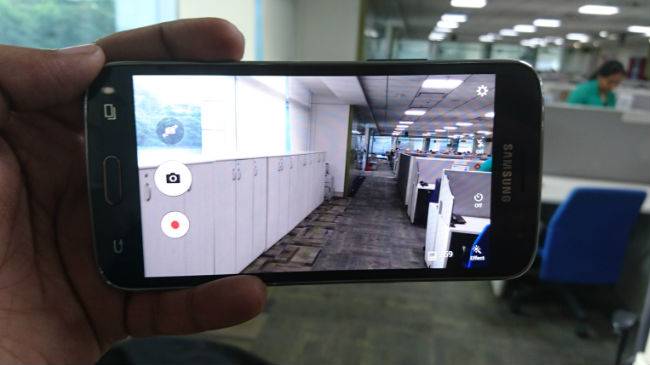
The camera is quite poor when it comes to shooting pictures indoor, as it really struggles with artificial light. In indoor low light scenarios, the situation is even worse as camera produces really muddy and dark images with a lot of noise.
The camera is also quite slow to focus and process images.
A big disappointment is the fact that the rear camera cannot shoot 1080 p HD videos, which is quite astonishing in this day and age in a 10,000-rupee smartphone. 720 p video shot by the camera is just about okay, usable only for Facebook or WhatsApp.
The front shooter is a big improvement from the previous J2, and is more than capable of handling your social media selfies.
Battery Life
The Samsung Galaxy J2 is powered by a 2,600mAh battery unit which is average at best. The device can make it through one day of light to moderate use. However, intensive use kills the battery before the sun sets.
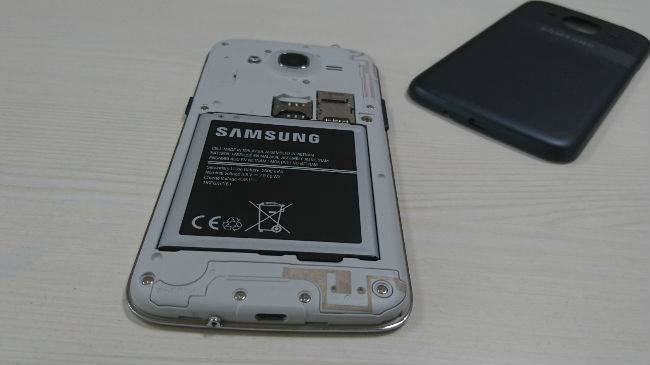
Samsung's also has a rather nifty ultra-power saving mode, which applies a greyscale theme to your device.
What is really disappointing is how long the device takes to charge. It takes 3 hours to charge the device fully and using it with a fast charger yields no noticeable improvement.
Likes
The Samsung Galaxy J2 2016 has a decent screen and battery life and the device is quite compact and easy to use in one hand. The front camera is above average and S bike mode can be useful for some.
Smart Glow is a nice addition, and is genuinely useful in certain scenarios but is not implemented practically.
Dislikes
The Samsung Galaxy J2 2016 has a mediocre and uninspired design, questionable build quality, excruciatingly dated and slow internals and lacks basics such as an ambient light sensor, haptic feedback and a secondary noise cancelling microphone.
TST fails to deliver and the device is slow and laggy, and performs rather poorly. Smart Glow is a nice feature, but is not practical.
The display lacks Gorilla Glass protection, the rear camera produces very grainy and noisy pictures in low light and the camera app is slow to focus and process images.
It doesn't come with a fingerprint sensor, which is present is many of its competitors and the internal storage is a paltry 8GB, which yields only 3.6GB usable space for applications.
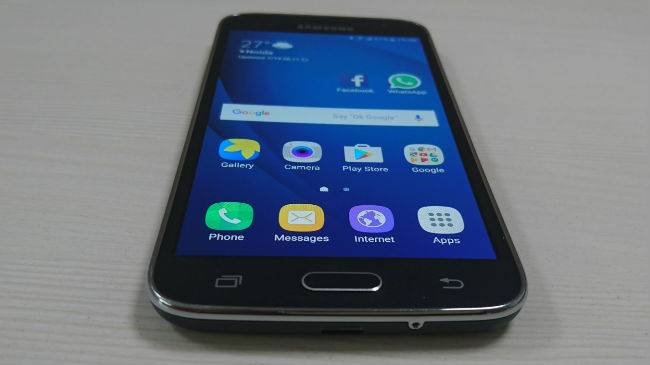
Verdict
The Samsung Galaxy J2 is not worth Rs 9,750 in any way.
While it does have a few positives with a good display, compact dimensions, above average front camera and decent battery life, it compromises on too many essentials to be a good buy.
TST is nice, but no amount of software optimization can compensate for the extremely slow and dated CPU and GPU. In addition, the woeful 8GB of internal storage, lack of basics such as the ambient light sensor, the lack of Gorilla Glass and the all plastic build contribute to making the Galaxy J2 2016 an extremely mediocre offering.
Smartphones such as the LeEco Le 1S Eco, the upcoming Moto G4 Play and the slightly more expensive Xiaomi Redmi Note 3 are much bettery buys.
Also read : LeEco Le 1s Eco review
Features Writer at NDTV Gadgets 360. Past - Sub Editor at India Today Tech, Content Writer at TechRadar India. A PG diploma holder in English Journalism from IIMC, New Delhi. Avid tech enthusiast, cinema buff, voracious reader and Formula 1 fanatic.
